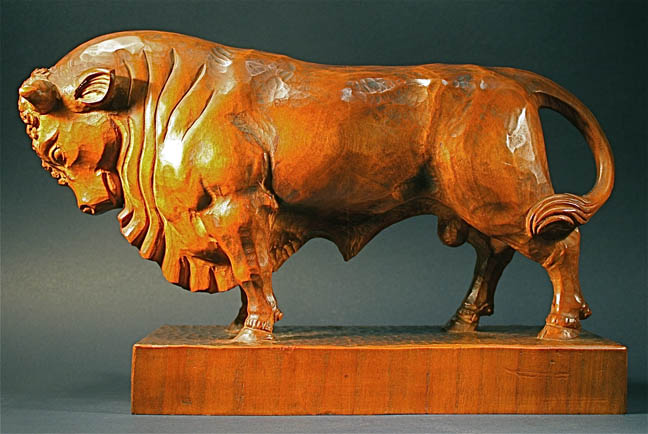

Title: Large Antique Art Deco Graphic Wooden Hand Carved Bull
Shipping: $29.00
Artist: N/A
Period: 20th Century
History: N/A
Origin: N/A
Condition: Excellent
Item Date: 1920 to 1940
Item ID: 2729
Wooden antique sculpture and Carving of a art deco bull figurine. This is one of the best I have ever seen. This is an entirely hand-carved item in a hard wood, please allow for possible slight variations in dimensions as well as in the wood's natural grain. Art stiles, traditions and culture pass on from generation to generation. This artist A masterful carving is wonderful. Capturing the muscular elegance of a bull as moves within wood. The bull heavy countenance is well detailed and recreated with reverent esthetics, brought to life by the powerful presence of the animal's eyes. The shapely image is dictated by the direction of the graphic art deco carving. *Our job is to find and target great art by collecting a vast array of contemporary, vintage, antique and collectible items from across the globe. Individually handcrafted, we breathe new life into these forgotten relics by giving back each piece it's unique story. We welcome dealers, galleries, and private collectors to register securely and buy with us.
Link: http://en.wikipedia.org/wiki/Wood_carving
Wood carving is a form of working wood by means of a cutting tool held in the hand (this may be a power tool), resulting in a wooden figure or figurine (this may be abstract in nature) or in the sculptural ornamentation of a wooden object. The phrase may also refer to the finished product, from individual sculptures, to hand-worked mouldings composing part of a tracery. Some of the finest extant examples of early wood carving are from the Middle Ages in Italy and France,[citation needed] where the typical themes of that era were Christian iconography. In England many complete examples remain from the 16th and 17th century, where oak was the preferred medium. Figural carving seems to have been widespread. The carving to represent one's god in a tangible form finds expression in numberless ways. The early carver, and, for that matter, the native of the present day, has found a difficulty in giving expression to the eye, and at times has evaded it by inlaying this feature with colored material.